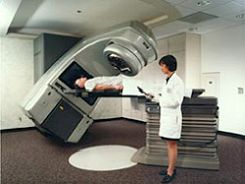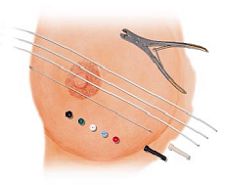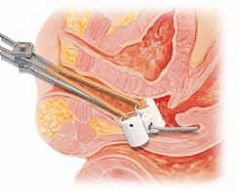Treatment Modalities
Photon Beam Therapy
 Photons are x-rays produced with a machine like the linearaccelerator or gamma rays from a Cobalt-60 unit. These highenergy photons are capable of penetrating deeply into tissues toreach deep seated tumours while actually delivering lessradiation dose to superficial tissues such as the skin. The actualphoton energy chosen to treat a tumour depends on thecharacteristics of the tumour, patient and treatment technique. The linear accelerator is capable of rotating around a patientlying on a treatment couch, treating the tumour from severalangles More often, two or more intersecting beams of radiationare directed at a tumour from different directions.
Photons are x-rays produced with a machine like the linearaccelerator or gamma rays from a Cobalt-60 unit. These highenergy photons are capable of penetrating deeply into tissues toreach deep seated tumours while actually delivering lessradiation dose to superficial tissues such as the skin. The actualphoton energy chosen to treat a tumour depends on thecharacteristics of the tumour, patient and treatment technique. The linear accelerator is capable of rotating around a patientlying on a treatment couch, treating the tumour from severalangles More often, two or more intersecting beams of radiationare directed at a tumour from different directions.
Electron Beam Therapy
Most patients are treated with x-ray beams produced by linear accelerators. These accelerators can also produce a beam of high-energy electrons which penetrate into tissue to a much more limited depth than x-rays. The treatment effect of electrons and x-rays is considered identical. Electron beams can be used for treating superficial tissues such as skin, lymph nodes and whenever it is preferable to deliver a higher radiation dose superficially and relatively less dose to deeper tissues.
Conformal Three Dimensional Radiotherapy
The objective of radiation therapy is to deliver a high dose to the tumour to achieve a high level of local control while keeping the dose to neighboring healthy tissues as low as possible.
 In conventional radiation therapy, the dose distribution can only be evaluated in a single, usually transverse, central plan although the tumour and the neighboring tissues bear complex three-dimensional relationships to one another. To ensure that the tumour receives an adequate dose, a margin is included around the tumour volume to account for the uncertainties in tumour delineation and dosimetry and deviations due to patient movement. This safety margin often limits the delivery of a high dose to the target volume because of the tolerance of the normal tissues included in the irradiation.Three dimensional (3D) conformal radiation therapy is a sophisticated irradiation technique which allows a high dose delivered to the tumour while keeping the dose to the adjacent normal tissues below tolerance. 3D conformal therapy combines modern imaging technology (such as CT and MRI) for accurate tumour delineation with state-of-the-art computer planning systems for treatment planning and the latest development in linear accelerator technology such as the multileaf collimators for precise and sophisticated dose delivery.
In conventional radiation therapy, the dose distribution can only be evaluated in a single, usually transverse, central plan although the tumour and the neighboring tissues bear complex three-dimensional relationships to one another. To ensure that the tumour receives an adequate dose, a margin is included around the tumour volume to account for the uncertainties in tumour delineation and dosimetry and deviations due to patient movement. This safety margin often limits the delivery of a high dose to the target volume because of the tolerance of the normal tissues included in the irradiation.Three dimensional (3D) conformal radiation therapy is a sophisticated irradiation technique which allows a high dose delivered to the tumour while keeping the dose to the adjacent normal tissues below tolerance. 3D conformal therapy combines modern imaging technology (such as CT and MRI) for accurate tumour delineation with state-of-the-art computer planning systems for treatment planning and the latest development in linear accelerator technology such as the multileaf collimators for precise and sophisticated dose delivery.
High Dose Rate (HDR) Remote Afterloading Brachytherapy
 The radioactive source transfer unit employs a high-activity miniature iridium-192 seed attached to the end of a steel wire to deliver the radiation treatment under computer control. In this way, the position of the source within the patient's body and the length of time it remains can be accurately controlled. Applicators for cancer of the cervix and breast Various devices, or applicators, are used to provide access for the radiation source into the area to be treated within a human body. Different applicator designs are available for treatment of tumours or other lesions located at different areas of the body. The applicators are placed within the patient (who is an esthetised if necessary, depending on the site to be treated). To prepare for the treatment, non-radioactive markers are placed inside each applicator, and X ray films are taken to visualise the actual setup.
The radioactive source transfer unit employs a high-activity miniature iridium-192 seed attached to the end of a steel wire to deliver the radiation treatment under computer control. In this way, the position of the source within the patient's body and the length of time it remains can be accurately controlled. Applicators for cancer of the cervix and breast Various devices, or applicators, are used to provide access for the radiation source into the area to be treated within a human body. Different applicator designs are available for treatment of tumours or other lesions located at different areas of the body. The applicators are placed within the patient (who is an esthetised if necessary, depending on the site to be treated). To prepare for the treatment, non-radioactive markers are placed inside each applicator, and X ray films are taken to visualise the actual setup.
Computer radiation dose calculations are done by the medical physicist who also performs machine quality assurance tests. After the treatment plan has been approved by the radiation oncologist, the applicators are then connected to the HDR brachytherapy unit and treatment is delivered.  Each treatment takes about 30-60 minutes, including treatment planning time. The actual radioactive application only lasts for about 5-15 minutes. HDR brachytherapy is customised to each patient, so an optimised radiation dose is applied within the precise contours of the target. The implants are temporary and treatment is given during a few concentrated sessions lasting minutes to hours as opposed to low dose rate (LDR) brachytherapy which typically requires that the radioactive sources remain in the patient for several days while the patient stays in the hospital.
Each treatment takes about 30-60 minutes, including treatment planning time. The actual radioactive application only lasts for about 5-15 minutes. HDR brachytherapy is customised to each patient, so an optimised radiation dose is applied within the precise contours of the target. The implants are temporary and treatment is given during a few concentrated sessions lasting minutes to hours as opposed to low dose rate (LDR) brachytherapy which typically requires that the radioactive sources remain in the patient for several days while the patient stays in the hospital.
 |
 |
||||
| Applicators for cancer of the cervix and breast | |||||
Low Dose Rate (LDR) Remote Afterloading Brachytherapy
 For some diseases such as cancers of the cervix, uterus or vagina, the radiation oncologist may choose to administer low dose rate brachytherapy. The radioactive sources are in the form of small caesium pellets which will be delivered remotely with the transfer unit into the hollow applicators which have previously been inserted into the body cavity by the radiation oncologist. The treatment time may last for a couple of days depending on the clinical indications.
For some diseases such as cancers of the cervix, uterus or vagina, the radiation oncologist may choose to administer low dose rate brachytherapy. The radioactive sources are in the form of small caesium pellets which will be delivered remotely with the transfer unit into the hollow applicators which have previously been inserted into the body cavity by the radiation oncologist. The treatment time may last for a couple of days depending on the clinical indications.
Manual Implants
Manual implants usually employ low-activity (hence low dose rate) material and could be either temporarily or permanently inserted into the body tissues or body cavity. The sources are usually much smaller than the LDR caesium pellets and may be in the form of seeds, wire, hairpins or needles etc.
